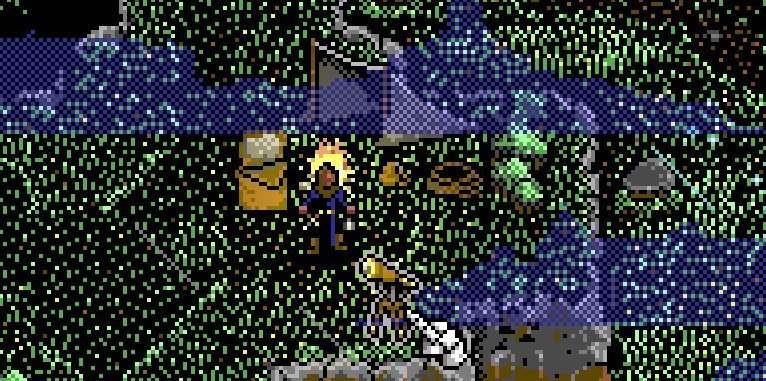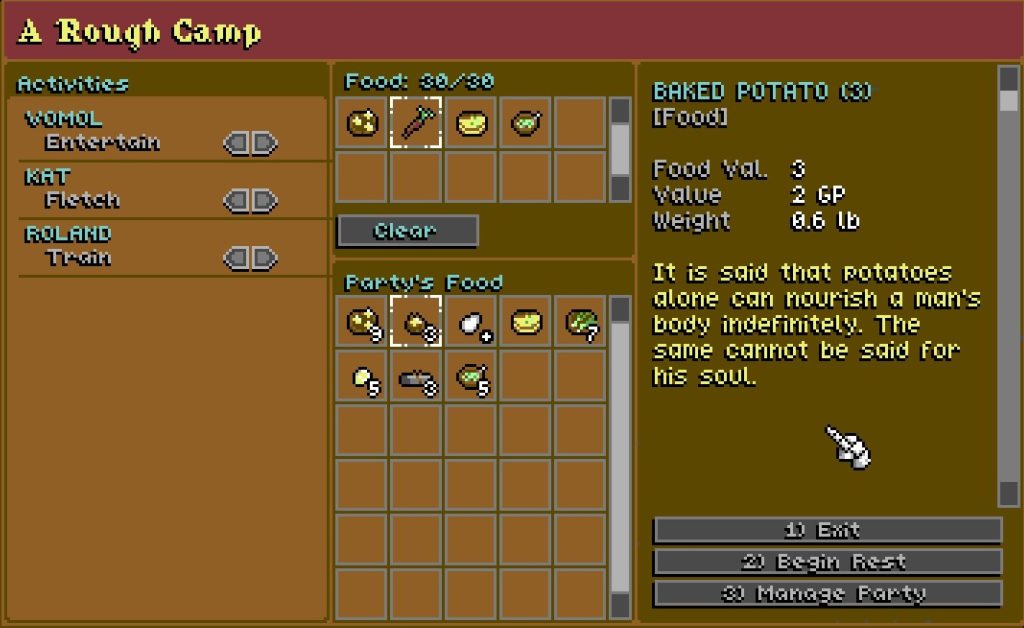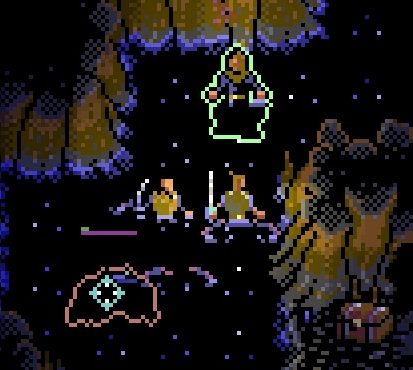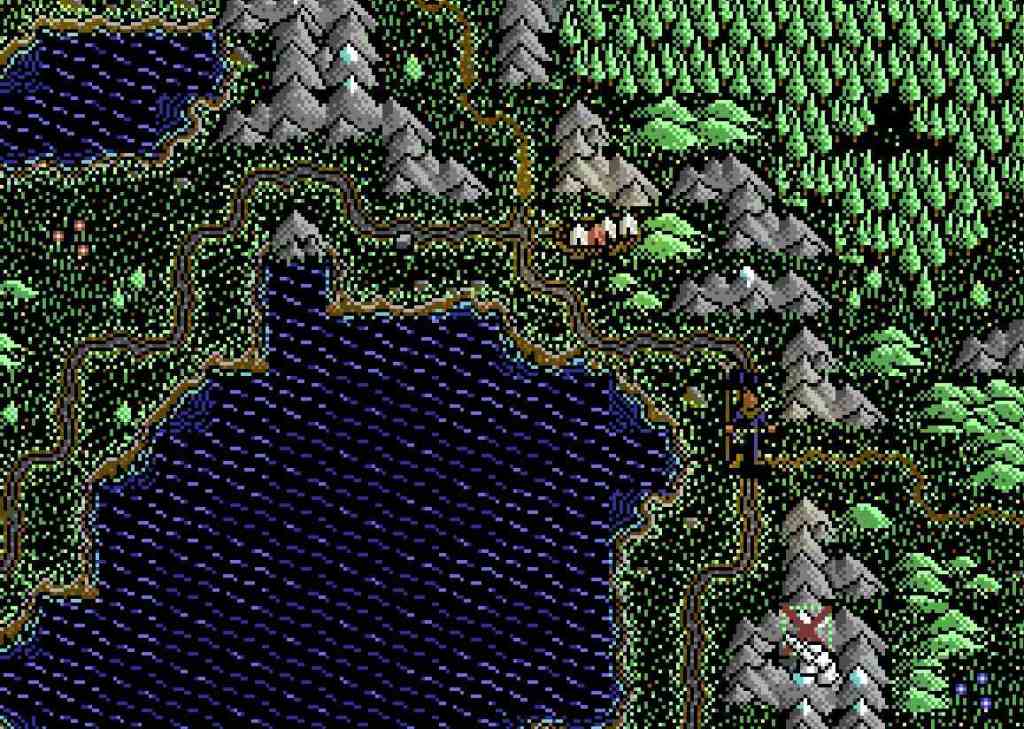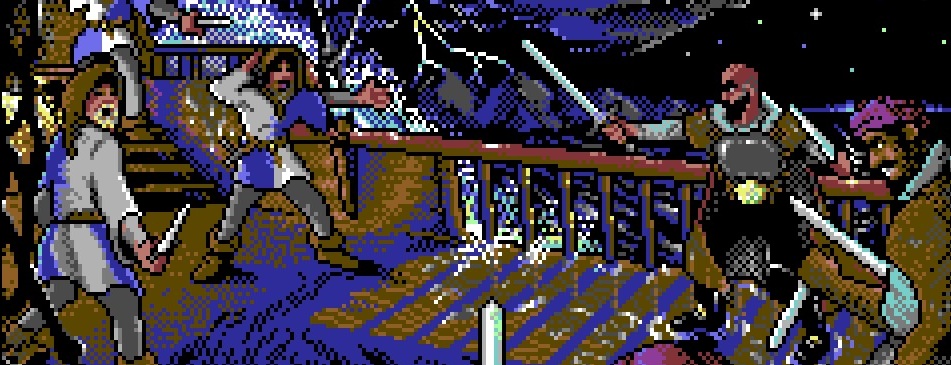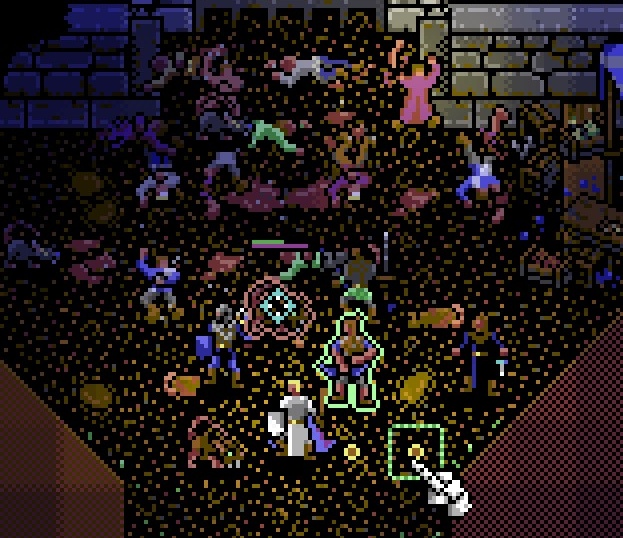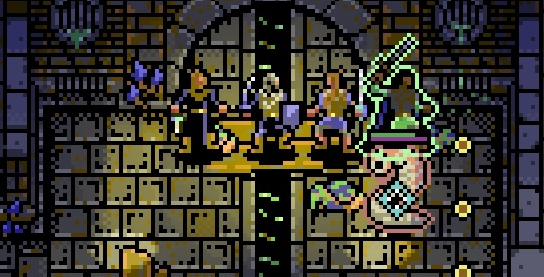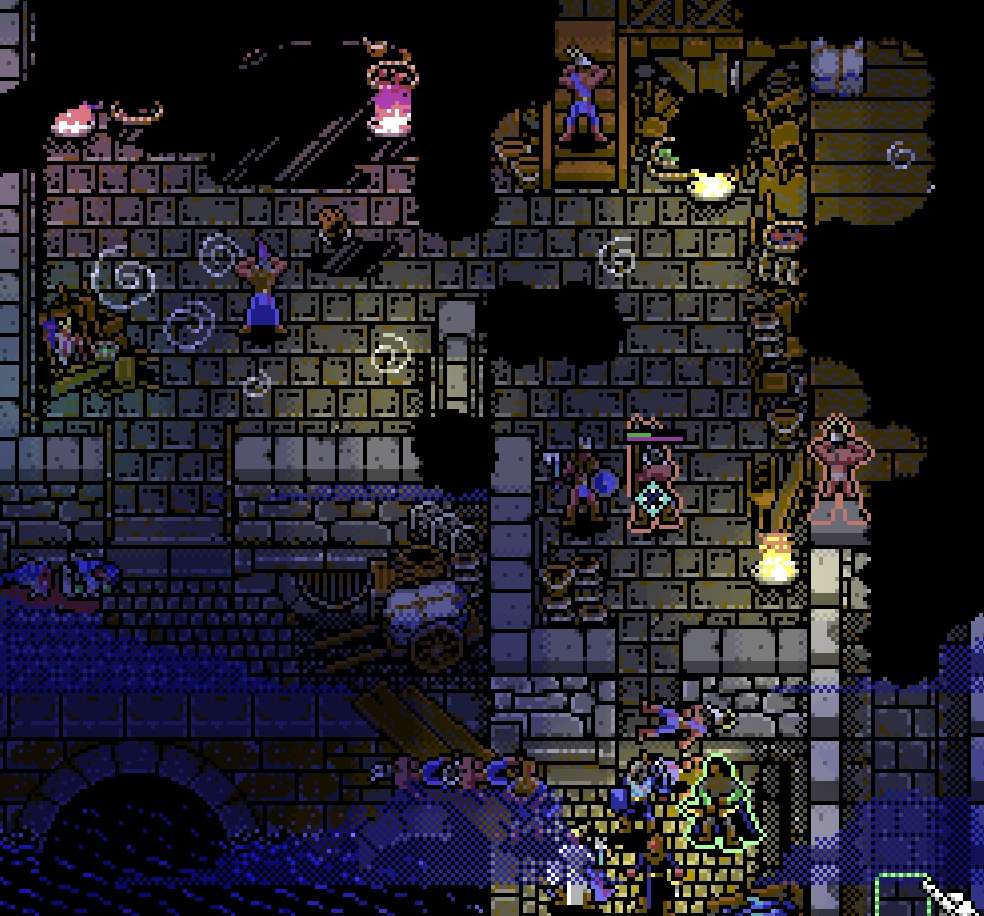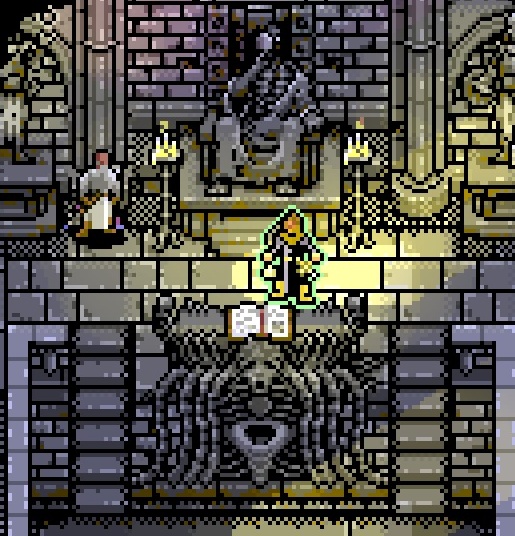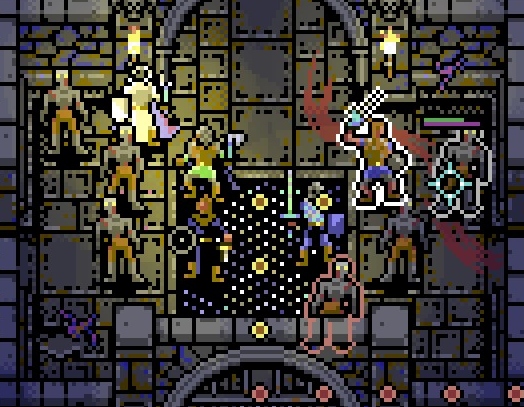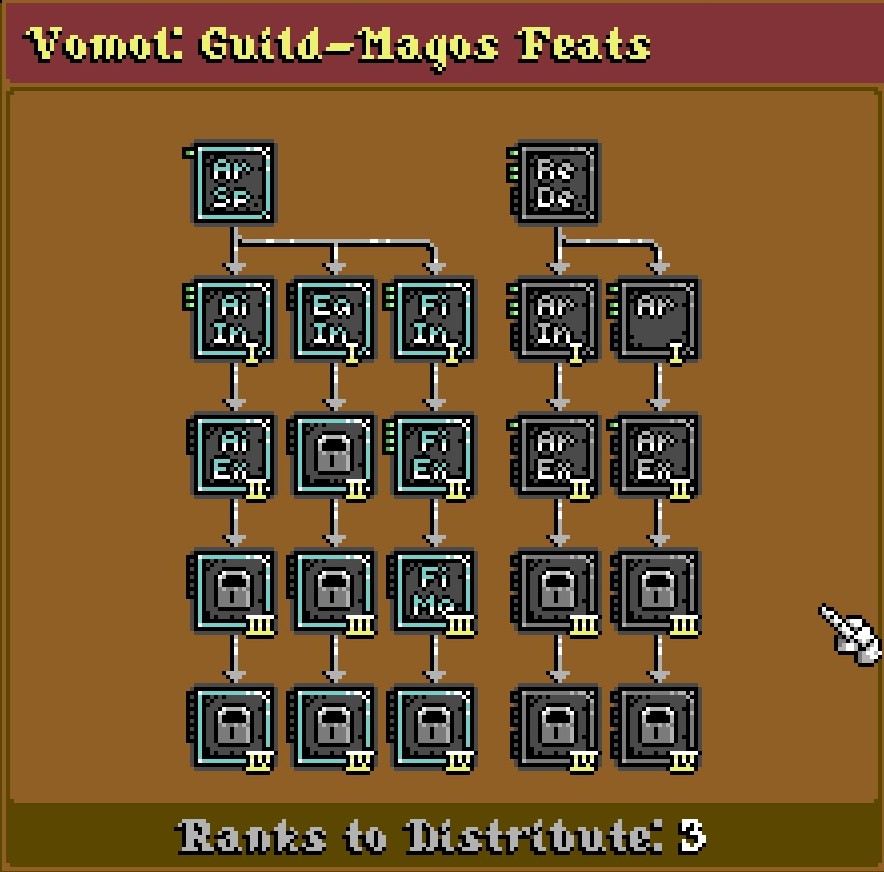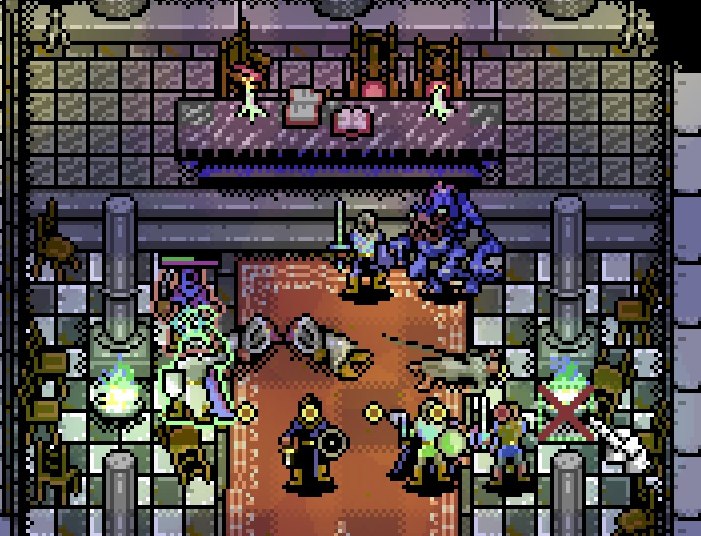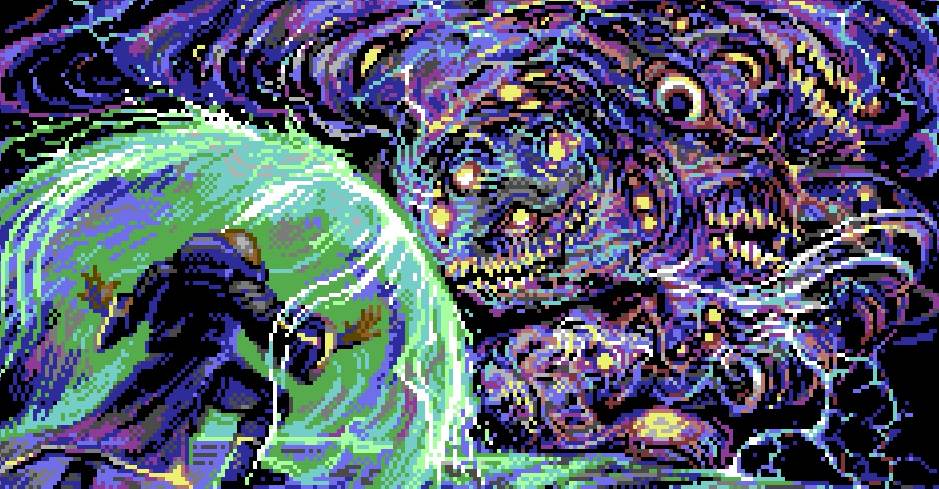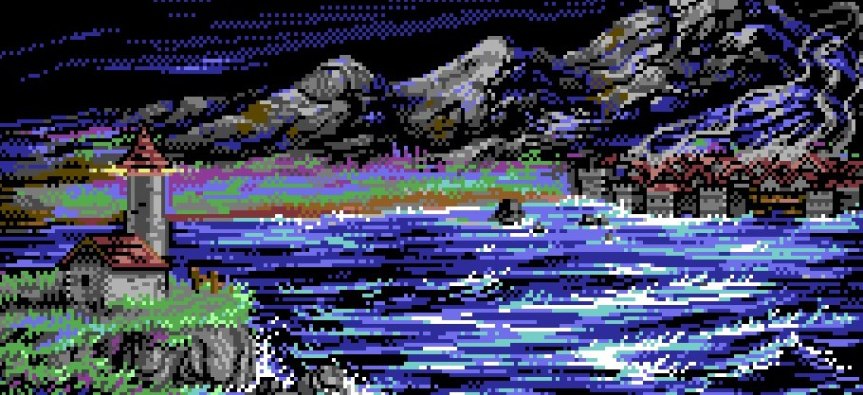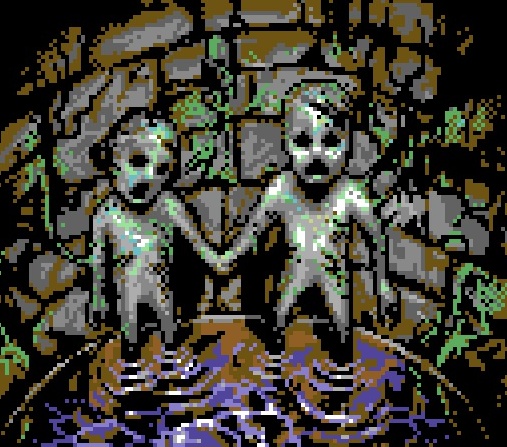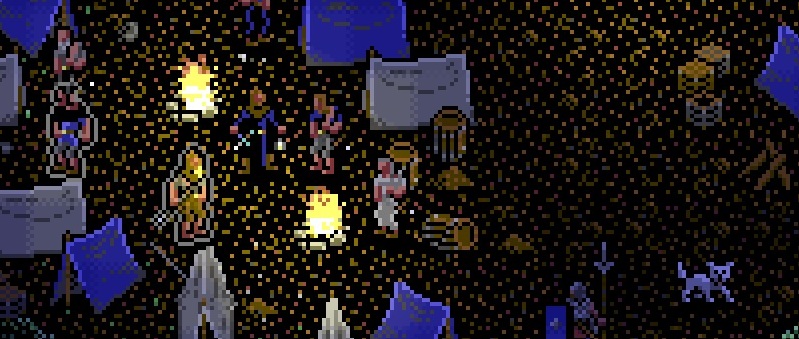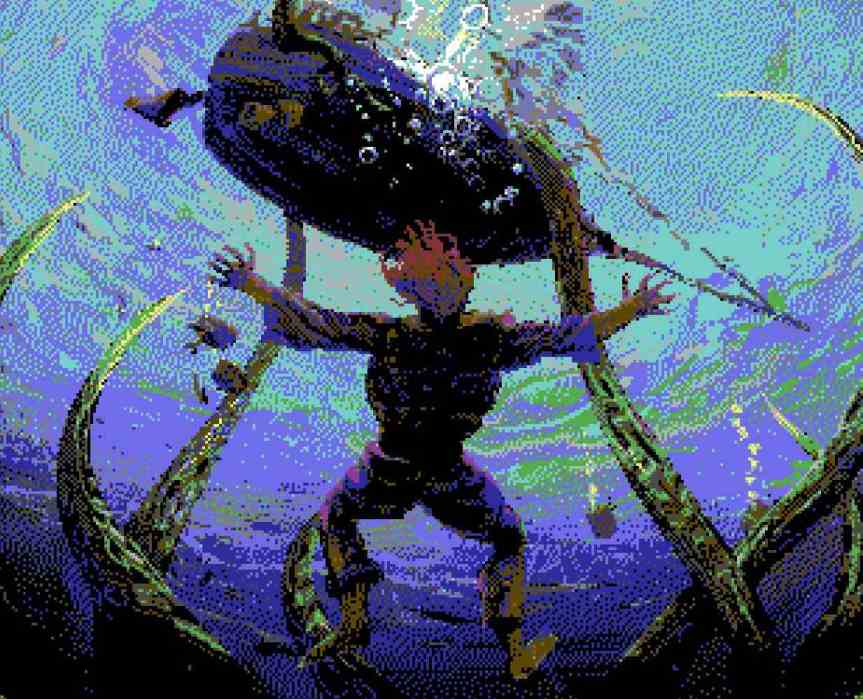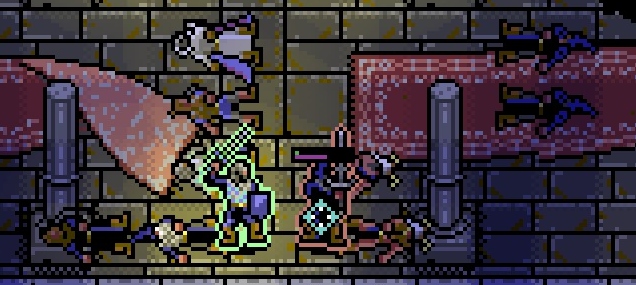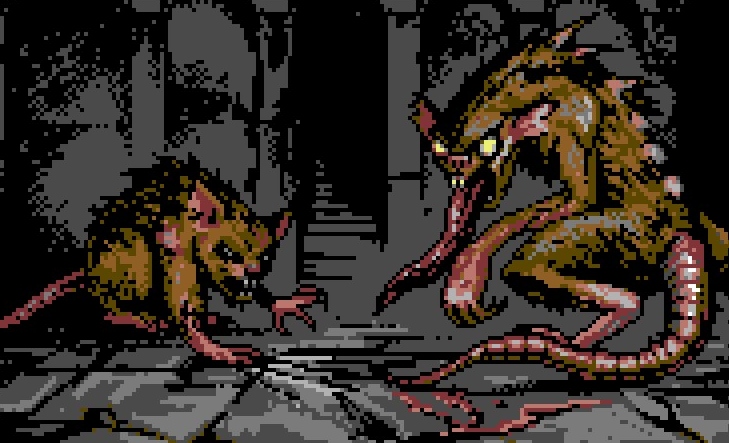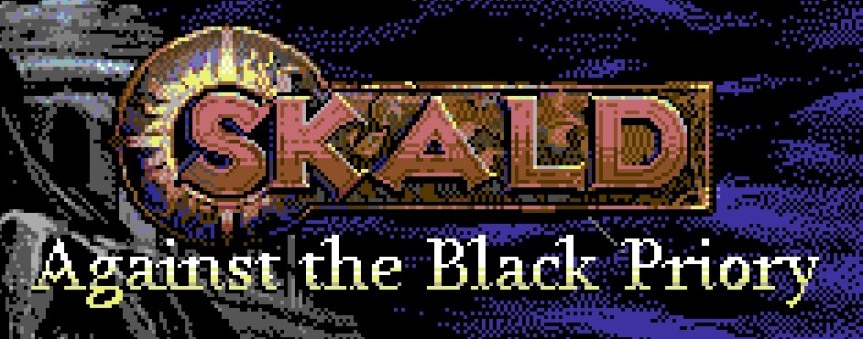
Polish your sword, and stock up on the travel weed, because it’s time to explore the cursed islands of SKALD: Against the Black Priory. While I don’t have much of a personal nostalgia connected to the Commodore 64, the graphics still manage to warm me in its low-pixelated glory of the past. However, it’s not without issues, as the amount of detail can actually be a detriment on this somewhat humble scale. At times it’s hard to distinguish the environment, seeing where you can or can’t go. It means when playing with a keyboard, you will have to prepare yourself to slam into objects like a bumper car trapped inside a tiny arena with randomly placed walls all over. Outside of that, it’s a pretty fine party-based adventure in the style of classic Dungeons and Dragons fantasy.
Lovecraft island
It all starts with you on a ship, slowly approaching the ill-fated islands where someone you need to find has gone missing. Seeing as this is a story based on the cosmic horrors of Lovecraft, what else than a giant Kraken would come to ruin your day when nearing the coast? Things go sideways quickly with the ship dragged to the pitch-black bottom of the sea. You have luck on your side and make a miraculous escape, washing your broken body up on the beach. After getting to your senses and realizing that you are somehow still alive, your only choice is to make it inland to figure out what happened to you… and to find the missing person you have been tasked with finding.
From here on out the adventure starts for real. You are set to level one with nothing to your name, no weapons, and no coins. Just how I like it, a brutal start from a state of zero, to eventually making yourself known through hardship and becoming a hero. Another aspect of this beginning I enjoy is that you are essentially doing mercenary work, a premise I find fitting for any fantasy adventure. Coin and fame are always a great motivator for any character. However, that is not the only reason, because the person you must find does have a connection with you. So, it works either way, regardless of how you want to roleplay your character. But I must point out that the story is fairly linear. Your goal is to find this person, and to survive the doomed island of madness where almost everything wants to kill and eat you. There isn’t much free-form here besides the exploration – think the first Baldur’s Gate doing a good campaign but with fewer towns to visit.
When it comes to Lovecraft and gaming, it’s more often than not just references with deep ones trying to munch on your insides. Missing the cosmic horror of man just being a speck on the playground of the old gods. I’m happy to tell you, that while there are a few Lovecraft call-backs, the story setting is unique and is told well. The narrative is quickly laid out that something is deeply wrong with this hopeless island. That the madness being spread among the human and animal population is something way out of your league to fix. Making the whole quest a doomed endeavor, at least, it’s the feeling SKALD conveyed to me, all the way up to the end. That’s not to say you will not be smiting a few Lovecraftian monsters and bad guys on the journey, but comparable to the unknowns of the cosmos, these creatures and men of wickedness are small fish in a gigantic pond with eternal depth. I loved it, and it felt intriguing right from the start when the ship was pulled apart and dragged underneath the foaming sea.
Ending oddity
In my press copy of the game, the ending slides are just black pictures with lorem ipsum text, meaning I don’t actually know how SKALD ends. I wrote to the publisher about this because I considered it an issue. How am I going to give it a fair review if I can’t tell how it finishes? Now, 99% of the game is fine, but maybe the ending says; “It was all a dream“. That would certainly change my opinion of the game. Anyway, the answer I got back was this was the review branch, and that the game would be complete when it launches. A tad bizarre, to be honest. So, a warning. I don’t know what the ending entails. I can only pray it’s good.
The slaying
Building your character and understanding the attribute system shouldn’t be a problem for any veteran of cRPGs or for any genre rookies for that matter. The names are switched from DnD, but everything is explained in-game with helpful tooltips. Luckily, it isn’t some kind of weird RPG system from the mind of Josh Sawyer (think Pillars of Eternity). So strength actually means strength. It’s only needed for warriors aiming to decapitate their foes, instead of being a crucial pick for wizards wanting to improve the damage of their magic missile spell. These attributes also govern non-combat-related skills. Crafting requires the intelligence attribute, while fortitude regulates survival which measures your cooking talent, and general survival skills in the wild. The system works well, it feels intuitive and very easy to learn.
What differs from DnD is that you never get you increase your main attributes through classic means by leveling up (from 3E editions, before that version, it’s very similar). When you level up, you get three points to distribute in your pretty extensive talent tree that is unique to the class you have chosen. Here you will pick from everything from active combat skills to pure stat increases, attributes included (which is the only way to increase it, beyond gear). It follows a straight line downwards, with the juiciest stuff being at the bottom, or at the end of each “feat” section. Each feat consists of six-point slots, so to maximize a feat, you will have to spend six points, which is two levels of leveling. But one point in a feat is enough to unlock the next one that follows. This means that sometimes you might have to spend points on feats you are not that interested in. Don’t fret though, as each feat always grants you something, meaning that the point is never wholly wasted. Each first, third, and sixth slots give you something, with the final slot usually being an extra yummy skill to increase your fighting prowess. Confusing? It’s not, I promise. The tooltips explain everything and the graphics make it very easy to follow and plan out what you want to become.
The battles take place in a turn-based system, with action points determining movement with attacking usually ending the turn. There are no saving action points for multiple attacks since this is entirely controlled through the feats picked. In melee, you can’t attack diagonally, which means the only way to engage is from the top, bottom, and the sides. It limits the surrounds to four characters. However, magic and ranged attacks with a bow can be done from any angle. To maximize your damage, it’s best to spread out roles between melee and ranged because if you don’t, the battles can get messy very fast. There are two reasons for this. Each unit occupies a physical place that can’t be shared with any other. And you can’t move through your comrades. The only way to get passed is to take over that spot, and that takes a turn, which effectively wastes that turn for the party member in question. It’s a double-edged sword. While tight spaces can spell trouble when maneuvering your team, it also means that you can pretty easily trap enemy creatures for easy and safe killing for your ranged crew.
I do have to point out one major issue with the combat, and that is the lack of a combat log. There might be one, but I couldn’t find the option to show one regardless of my intense search for it. When I looked at the save files in Windows, I did notice that the game tracks the stats and rolls, yet for some reason, I couldn’t activate it in-game. It’s a major detriment if you like to know why an attack was missed, or why you were randomly critted to oblivion. It could be that this part is missing from the press release of the game, but who knows? I hope it’s something that gets added or is something I overlooked somehow.
Update: 2024-06-01
There is a combat log. It’s option number eight on the quick bar and you can only access it during combat. Somehow it escaped me totally for twenty hours straight. The only excuse I can give is that it only magically pops up during fighting, and the icon looks like it could be some kind of journal. Not something I would decide to look at in a battle. As said, I searched for a way to activate it through keyboard commands, but I didn’t think it would be context-sensitive only, and only on the quick bar. Anyway, good to know for a future playthrough!
Social fun
One of the best parts of SKALD: Against the Black Priory is that it’s a party-based RPG of the old variant, namely having a big party of six. The more the merrier I usually say, and this game surely satisfies. The game will provide you with characters with a history, personality, and their own reasons as to why they are there, but you can create your party members for a fee of gold if you want. I stuck with the characters the game gave me since I enjoyed them all, even if they didn’t say that much during the events of the adventure. However, when they do, it matters, and it makes it so much better than being exposition dumped every ten minutes which so many modern RPGs suffer from. I played on the normal difficulty setting and found it very suitable for my skill level. But, I have a feeling if you create extra characters, SKALD might become too easy. You see, you won’t have a full party until you reach the middle of the journey, so many fights seem to be balanced around the fact that you don’t run a full party.
Outside of combat, your companions also matter, as you can pick whoever you want for the skill checks, and there are plenty of those. It’s as easy as pressing Q to switch characters, so if you need someone to talk your way out of a bad spot, it might be an idea to change to the sweet-talking hospitaller, instead of letting the conversation be controlled by the dumb brute with a large axe slung over his shoulders. These non-combat skills also play into the crafting and survival – for example, cooking. To fully heal from wounds, and “permanent” injuries that affect skills, you need to eat and rest. And to get a full night (or day) rest food is a requirement. It means that finding and cooking food is a major feature of SKALD, which is an aspect I really enjoy. Raw food might provide a few points of replenishment, but cooked food, especially if it consists of several different ingredients gives a huge boost. While food will eventually take a large spot in your inventory as far as weight goes, I highly recommend keeping all edibles around. Not being able to heal before a critical moment will spell dire news for your team.
Other skills are stealth, and crafting, like brewing potions. As not to make this review endlessly long, I will just say that all skills have a point, and work well. Nothing feels left out. Everything serves a purpose, depending on how much you feel like investing in it. Recipes for crafting and making food can be found or bought, or you can experiment with ingredients to unlock them. It’s a fun pastime if you like this kind of stuff.
The gameplay will keep you busy, solo or through the party. The systems are designed splendidly, and beyond what I have talked about, you also have the classics like collecting loot and choosing who gets to wear what, and what will be vendor trash. And not to forget, find synergies between your team to form the ultimate squad for wiping out cultists and Lovecraftian fiends. It’s very enjoyable from the view of an archetypal fantasy romp through hostile lands that need saving. Another side of the SKALD that has to be established is the greatness of the exploration. It’s sectioned into two parts, the overworld map, and the actual areas of that map, like caves, towns, and such, where you talk to people and fight with monsters from the deep. Nothing is pointed out where to go, as in following some kind of visual indicator a la quest objective. You are left to your device. It means that you need to follow the text provided in your journal and listen to what folk have to say. It’s the preferable way of doing fantasy adventure since all exploration is up to you and your box of grey goodies upstairs. There are plenty of secrets to undercover, and going by my achievements at the end, I missed out on two major quests that required a bit more input than I was putting in at that moment.
Pixel greatness
The retro visuals are a pleasure to look at, and it’s surprisingly detailed for being this low-pixelated. You can make out every kind of weapon and gear on your characters, which is very impressive considering what the artist had to work with. However, as mentioned at the beginning of the review, it’s not without some minor issues, especially during nighttime. I found it very hard to make out where I could go, and what was blocked off when it came to differences in terrain height. It doesn’t change much, but it puts a hamper on things when exploring. Hearing yourself bumping into things constantly like a machine gun with the dullest sound ever gets a bit grating. Other than that, the graphics presented are excellent, and beyond the visuals when traversing the land, the pictures of people and significant events during the game are very beautiful. The same goes for the menus and UI. They are very fitting, and never take you out of the game.
SKALD has no voice acting, which leaves me to critique the general audio and music only. And what do you know, it’s excellent. I’m glad that they didn’t go full retro PC-speaker type of sound effects, as that would have been incredibly annoying after a while. Yet, both music and sound effects have a slight tone of retro to them nonetheless. The lack of voice acting I don’t mind, especially if we go by its retro Commandore style and top-down view. For the most part, I find voice acting in these types of RPGs to be damaging to the pacing of the story. I often read faster than the actual voice recording can spit out the lines. And letting your imagination take over for the voices is never a bad thing. All in all, the presentation is top-notch!
Conclusion
SKALD: Against the Black Priory is an excellent party-based RPG with good turn-based combat, and a Lovecraftian story that plays into the tropes well – without it feeling like re-tread (not too much at least). The writing overall is outstanding, and it impressed me with how engaging it felt, especially nearing the end of the game when it all came together (well, except the ending, considering I have not seen it yet). It’s a highly enjoyable game, and I have no trouble at all recommending it to everyone wanting a new fantasy adventure to set their teeth into. A warning though. I finished it in about twenty hours, so don’t go expecting a mastodon title in the form of Baldur’s Gate 3, lasting for hundreds of hours. However, it allows for a replay or two, if you go by classes since there are a few different combos to try out. Let’s hope it’s a success for the studio High North Studios, so they can release more games in this style.
Thanks for reading.
/Thomas
– Review copy provided by publisher –
| System: | PC (Steam) |
| Played with: | Mouse & keyboard |
| Mods/fixes: | None |
| Enjoyment rating: |
